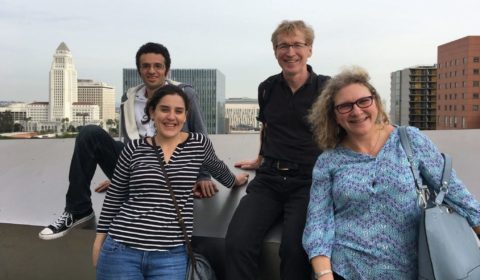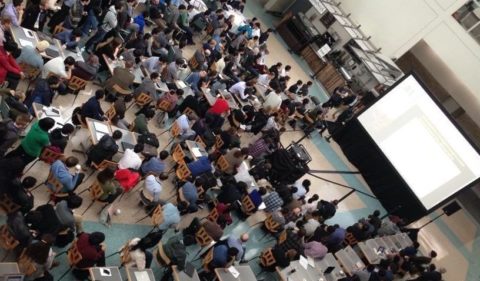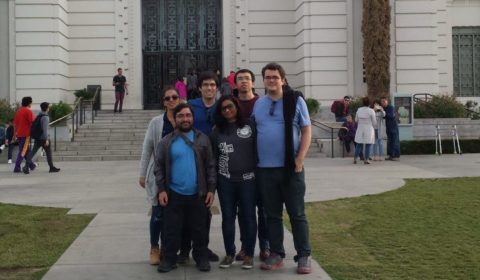
Former NQPI student Mahmoud Asmar (currently a post-doctoral associate at the University of Louisiana), former visiting student Mariama Rebello (now an assistant professor at the University of Richmond), Markus Morgenstern (a professor at the University of Aachen, Germany), and OHIO Physics & Astronomy professor Nancy Sandler meet during the American Physical Society March Meeting, at the Disney Hall in Los Angeles.
By Amanda Biederman
NQPI editorial intern
Each year, the American Physical Society’s March Meeting brings together thousands of scientists from around the world, featuring the most current findings in condensed matter physics research (the APS hosts another meeting for Nuclear and Particle Physics, in addition to other specialized meetings throughout the year).
The conference presents an opportunity to learn about research from a variety of areas, said Dr. Horacio Castillo, Associate Professor of Physics & Astronomy.
Four OHIO Physics & Astronomy professors and Nanoscale and Quantum Phenomena Institute members – Castillo, Dr. Nancy Sandler, Dr. Eric Stinaff and Distinguished Professor Dr. Alexander Govorov – attended the March Meeting in Los Angeles, together with Ohio University students last month. In total, eight NQPI members authored 24 abstracts presented as contributed talks.
“(This meeting), for me is very efficient in a way because in one trip you meet a lot of people and see a lot of things,” Castillo said, noting that he has attended the meeting almost every year throughout his career.
The March Meeting is known not only for its large crowd size (more than 11,000 people attended this year), but for being the “birthplace” for the announcement of many important scientific discoveries, Sandler said. In 1987, during a meeting that would later be remembered as the “Woodstock of Physics,” a series of recent breakthroughs regarding high-temperature superconductivity were presented in a session that lasted through the night.
This year, another major discovery was announced at the meeting: Scientists reported that by stacking a pair of graphene sheets on top of one another, they could create ultra-thin materials with superconductive properties. Sandler noted that this talk took place in a room that was overflowing with attendees, and the organizers set up a special screen to stream the talk across the larger venue.

Massachusetts Institute of Technology professor Pablo Jarillo-Herrero announces the discovery of superconductivity in bilayer graphene. His highly anticipated talk was live-streamed to attendees in the Los Angeles Convention Center to accommodate overflow in the session.
“This particular conference is special,” Sandler said. “People announce big discoveries here.”
The March meeting is known for more than major discoveries and abundant networking opportunities. This conference also holds events of social relevance, Sandler said. These include professional readings of plays related to science; this year, the meeting hosted a reading of Silent Sky, a play featuring women who were used as “computers” in Harvard Astronomy labs in the 1950s.
In addition, the conference hosts manufacturer exhibitions, editorials, prestigious award ceremonies, workshops, and social events for attendees.

OHIO students and alumni convene during the conference. Back row: (left to right): Natalia Cortes (USM), Oscar Avalos Ovando (OHIO), Dawei Zhai (OHIO). Front row: (left to right): Juan P. Ramos (USM), Ruhi Thorat (OHIO), Tomas Rojas Solorzano (OHIO)
For students and early career scientists, the massive size and unique nature of this conference present unique opportunities for networking and career development. Oscar Avalos Ovando, a Ph.D. student of OHIO Physics & Astronomy professor Dr. Sergio Ulloa, said conferences offer an opportunity to build professional connections with potential collaborators. Because the March Meeting garners a particularly large attendance, he had the option to meet with experts in almost any field.
“We’re always looking for potential collaborators at meetings,” Avalos Ovando said. “I’ll go through the program to look for interesting experimentalists, and I will always try to talk to speaker afterwards. You never know what will happen.”
Avalos Ovando said he is grateful to the leaders of his research group (Ulloa and Sandler), as well as NQPI and the Condensed Matter and Surface Sciences program for supporting student travel to conferences.


















Comments